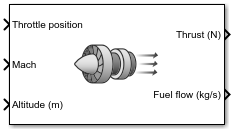Turbofan Engine System
Implement first-order representation of turbofan engine with controller
Libraries:
Aerospace Blockset /
Propulsion
Description
The Turbofan Engine System block computes the thrust and the fuel mass flow rate of a turbofan engine and controller at a specific throttle position, Mach number, and altitude. For more information on this system, see Algorithms.
The Turbofan Engine System block icon displays the input and output units selected from the Units parameter.
Limitations
The atmosphere is at standard day conditions and an ideal gas.
The Mach number is limited to less than 1.0.
This engine system is for approximation only and is not meant to be used as an engine-specific high-fidelity model. The engine system might not be scalable to large engine sizes.
This engine system is assumed to have a high bypass ratio.
Ports
Input
Output
Parameters
Algorithms
This system is represented by a first-order system with unitless heuristic lookup tables for thrust, thrust specific fuel consumption (TSFC), and the engine time constant. For the lookup table data, thrust is a function of throttle position and the Mach number, TSFC is a function of thrust and the Mach number, and engine time constant is a function of thrust. The unitless lookup table outputs are corrected for altitude using the relative pressure ratio δ and relative temperature ratio θ, and scaled by maximum sea level static thrust, the fastest engine time constant at the sea level static, sea level static thrust specific fuel consumption, and the ratio of installed thrust to uninstalled thrust.
References
[1] Aeronautical Vestpocket Handbook, United Technologies Pratt & Whitney, August, 1986.
[2] Raymer, D. P., Aircraft Design: A Conceptual Approach, AIAA Education Series, Washington, DC, 1989.
[3] Hill, P. G., and C. R. Peterson, Mechanics and Thermodynamics of Propulsion, Addison-Wesley Publishing Company, Reading, Massachusetts, 1970.
Extended Capabilities
Version History
Introduced before R2006a
